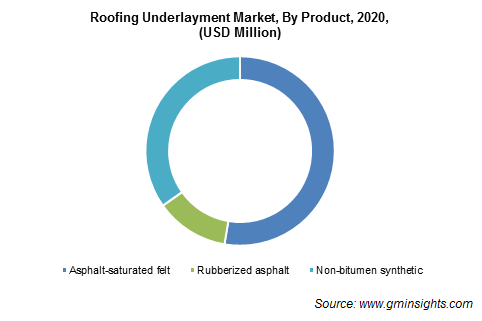Roofing Underlayment Market worth over $38 Bn by 2027
Published Date: November 2021
Roofing Underlayment Market size is set to reach USD 38 billion by 2027, according to a new research report by Global Market Insights Inc.
Growing residential construction activities in Asia Pacific will augment the roofing underlayment industry growth. The increasing spending on advanced housing facilities across emerging economies will further boost the market revenue.
Robust development in roofing techniques coupled with exponential growth in the construction industry around the world will propel the roofing underlayment market demand. Changing consumer preferences toward better housing facilities and other infrastructural needs are driving the global construction industry. Asia Pacific accounted for prominent construction growth in the past few years. Southeast Asian developing countries have huge infrastructure and building activities taking place due to gradual economic development. Additionally, the growing demand for affordable housing will fuel the residential construction sector across developing countries.
Get more details on this report - Request Free Sample PDF
The recent COVID-19 pandemic has adversely impacted business expansion owing to the cancellation of construction projects, disruption of the supply chain, and severe economic downturn globally. Governments and regulatory bodies have taken precautionary steps to combat the spread of coronavirus, which further limits revenue generation. However, the lifting of lockdowns across nations and rising economical activities will register sustainable growth.
Browse key industry insights spread across 190 pages with 144 market data tables & 27 figures & charts from the report, “Roofing Underlayment Market Size By Product (Asphalt-saturated Felt, Rubberized Asphalt, Non-bitumen Synthetic), By Application (Residential Construction, Commercial, Non-residential Construction), COVID-19 Impact Analysis, Regional Outlook, Growth Potential, Price Trend, Competitive Landscape & Forecast, 2021 – 2027”, in detail along with the table of contents:
https://www.gminsights.com/industry-analysis/roofing-underlay-market
Non-bitumen synthetic product to foster industry statistics
Non-bitumen synthetic product segment surpassed USD 9 billion in 2020 and is anticipated to exhibit a sizeable growth through 2027. Factors including lightweight, high-strength, typically non-skid, resistant to fungal growth, and excellent moisture & UV resistance capacity will support product demand. Widespread applications of these products will obtain a significant foothold in the marketplace and will acquire a prominent revenue share.
Non-residential construction sector to showcase sustainable growth
The non-residential application is likely to observe 4.7% gain till 2027. Growing economic activities and the demand for smart cities are boosting the non-residential construction growth. Factors including the development of shopping malls, retail centers, etc., along with increasing trends to reduce building energy consumption will enhance the market demand.
North America to account for a prominent share
In 2020, North America captured more than 35% of the roofing underlayment market share. A growing need for quality roofing materials that can easily adapt to severe environmental calamities such as storms, heavy snowfall, etc., will influence the regional industry. It acts as a waterproof barrier and protects the roofing structure. The rising number of aging homes in the U.S., increasing in-housing, and growing residential activities will further spur the product consumption.
Merger &acquisition will obtain a competitive edge
Some of the key industry participants are Atlas Roofing Corporation, Intertape Polymer Group, Braas Monier Building Corporation, Duro-Last Inc., Carlisle Companies Inc., Johns Manville, Certain Teed Corporation, VaproShield, DuPont de Numerous, Inc., Tamko Building Products, Inc., Gardner Gibson, Polyglass, Tarco, Owens Corning, GAF Materials, MFM Building Products Mfg., Boral Roofing LLC., Keene Building Products, IKO Industries, Inc., GCP Applied Technologies Inc., etc.
The global roofing underlayment market is highly fragmented, and companies are continuously investing in innovative business strategies to increase their geographical footholds. For instance, in February 2020, Atlas Roofing Corporation acquired StarRFoam, a leading manufacturer of molded polystyrene solutions. This acquisition will provide significant business growth to the company in the U.S. market.





